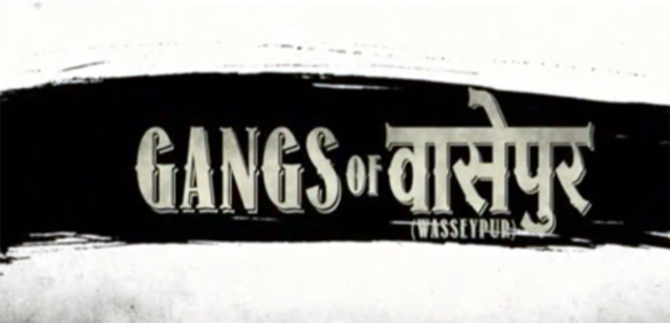*I wrote this as a part of my english assignment.*
Directed by: Anurag Kashyap
“Ik bagal
mein chand hoga, ik bagal mein rotiyan,
Ik Bagal
mein neend hogi, ik bagal mein loriyan.”
Gangs of
Wasseypur is story based on real life incidents that happened in Wasseypur
and Dhanbad across 30 years and 3 generations. Kashyap has kept the
movie undoubtedly real - except for certain stances of dragged unnecessary
scenes of humorous action - the ordinariness of it is what makes it
extra-ordinary, the unconventional “evilwinsovergood” ending strengthening its
ties to reality.
The plot
is a very complicated story made simple. Gangs of Wasseypur is a story
of revenge across generations. Set in Wasseypur, a village in Bihar, the
movie initially revolves around the increasing differences between the Pathans
and the Qureshis, while the Zamindars take advantage of this
gap and prosper out of it. Ramadhir Singh, the most powerful coal mine
contractor in town kills his sidekick Shahid Khan on discovering his plot to
overpower and possess his own coal business. A witness to this is his perceived
brother – ChachaJi and 7 year old son Sardar Khan. Growing up, Sardar
Khan has only one resolve – to seek revenge and kill his father’s murderers –
Ramadhir Singh and his aides -the Qureshis. And thus starts a legacy of
payback and betrayal. A story expanding over families and sons and sons of sons,
till Faizal Khan realizes that it should have all been over with Shahid Khan’s
death - this, after he has lost his entire family, except for his pregnant wife
and ChachaJi. It has certain masala movie nuances when children
from the enemy families fall in love with each other but this can be explained
away as an attempt to bring peace. This movie speaks of another important human
action – betrayal. The movie ends with Faizal Khan’s half-brother ‘Definite’,
this one man he trusted his life on, killing him. The irony however is
important to be noted, while on one hand Definite betrays his brother, he does
so to keep his mother’s trust. The good man dying while the bad survives- the perceived
villain winning while the hero perishes – this ending is avant-garde in Indian
cinema, something the audience might have been repulsed by, but it justifies
the real life incident this movie is based on. The last scene is Faizal’s wife
– Mohsina and their child dreaming away to a beautiful Mumbai Backdrop along
with the most consistent character in the movie, ChachaJi.
The acting
is at par or I could say above excellent. Richa Chaddha plays Nagma, Sardar
Khan’s eccentric 22 turning into 60 year old wife and has stood out. Manoj
Bajpai is true to his talent; Huma Qureshi has an important role to play in the
second part and is scintillating with her dialogue delivery. The “parmisan
lena chahiye tha nah” pierced through many hearts. The cast has done a
brilliant job giving in to what Kashyap had expected and there are simply no
complaints when it comes to that. The one man proving his worth has however
been Siddique, his character going through the most transitions while he
effortlessly juggles around. Even his ‘philmi-ness’ has managed to look
real.
The movie
was released in 2 parts, and unlike the first part, which is ‘perfectly fit’,
the second certainly has some extra baggage – these relatively unreal sequences
constitute around half-an-hour of the whole movie if put together. The scenes
however complement the dialogues and the acting. In spite of the extreme amount
of violence, this movie does not hurt the eye. It is explicit in terms of sex
and vulgar use of language, extremely overt in the latter in fact, but the
language has been used finely to create the required environment. Humour is
immense and woven with violence; it adds to the unconventionality of the movie,
something only Kashyap is capable is doing of. (Who else would call the
characters of his movie Dephinite and Perpendicular?) Intricate human emotions
are portrayed through relationships and romance. Although not shot at the
original locations, the film will push you into almost similar surroundings of
the standard Indian village in Bihar. The movie attracts mixed audiences given
its language and outer appearance. This movie has explored unknown territories
to emerge as exemplary in case of the “new” in Indian Cinema.
What
stands out the most in the movie, apart from brilliant acting, is the
sensational music by Sneha Khanwalkar. Khanwalkar has managed to fuse the west
with the east, folk with classical, music with noise and create something
refreshingly new and original. The explicitly ‘cheap’ innuendos used in the
lyrics combined with the electrifying sound effects have given birth to a new
genre in Bollywood.
Amidst the
backdrop of revenge, betrayal and violence, Gangs of Wasseypur has a
much subtler message to offer – the message of resistance and peace. Despite instances of backstabbing, it speaks
of being together through difference and of friendships beyond boundaries. And
it speaks of love. It speaks of choices and wrong choices and most of all it
speaks of human weaknesses and tolerance. Gangs of Wasseypur has no
heroes and no villains. It is a story which begins with circumstances and ends
with the same.

